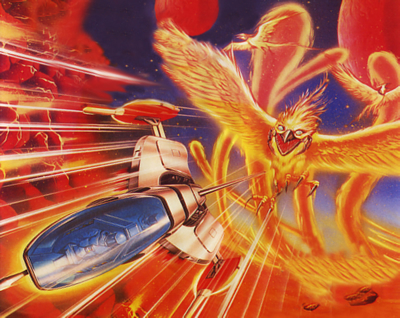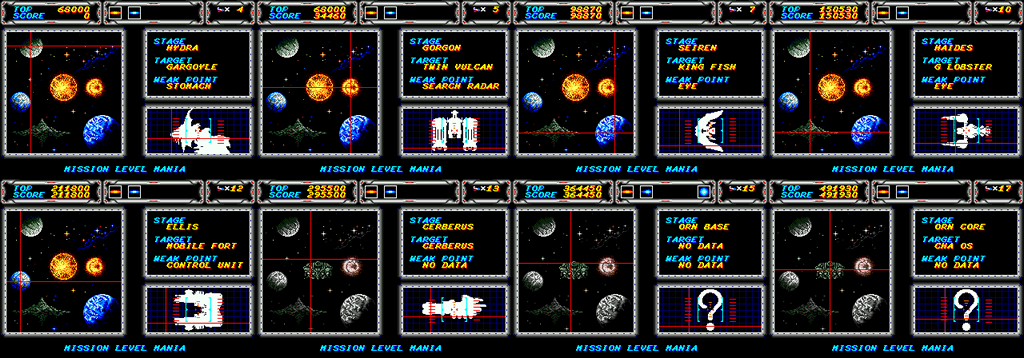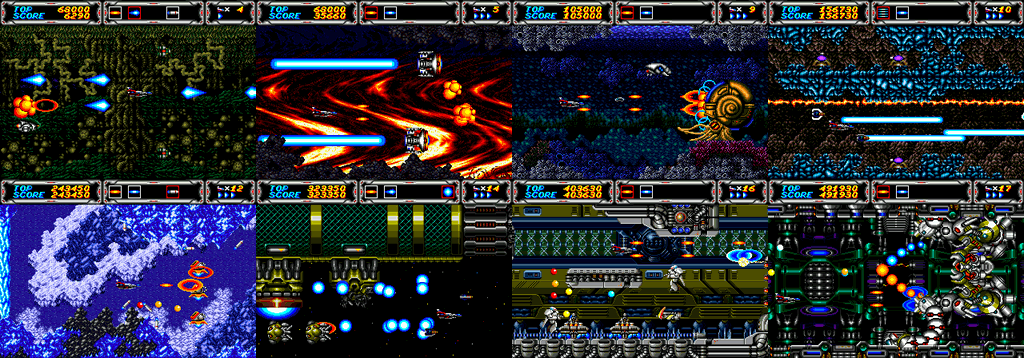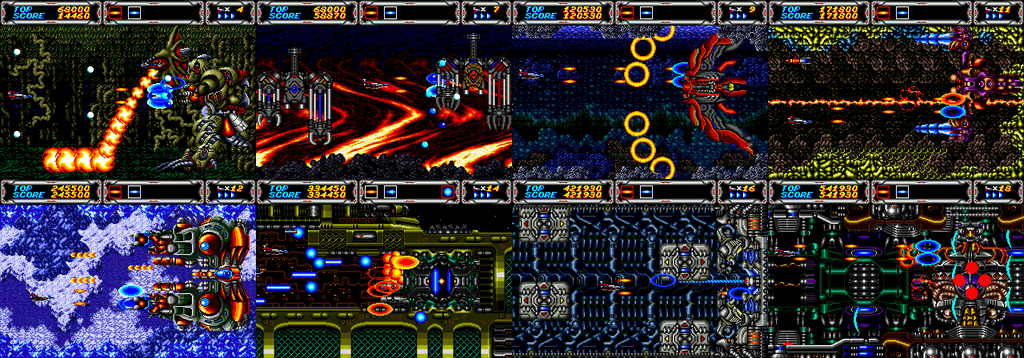 You know the story; we all do. One lone pilot takes off in his heavily armed spacecraft to take on an entire alien armada/empire. With only the furious steel around him and his wits to rely on, he overcomes ungodly odds to save his planet/the universe. Yes, we all know how it goes, and the proto-typical shooter story has almost become a parody of itself in that it’s about as original as an amnesiatic, angst-ridden teenager being the star of a Japanese RPG. Genesis fans know this plotline all too well, and they’ve seen it in dozens of shooters on the console. Though many don’t know it, Techno Soft’s masterpiece, Thunder Force III goes against the grain and attempts something really new to the genre. See, this game has two pilots!
You know the story; we all do. One lone pilot takes off in his heavily armed spacecraft to take on an entire alien armada/empire. With only the furious steel around him and his wits to rely on, he overcomes ungodly odds to save his planet/the universe. Yes, we all know how it goes, and the proto-typical shooter story has almost become a parody of itself in that it’s about as original as an amnesiatic, angst-ridden teenager being the star of a Japanese RPG. Genesis fans know this plotline all too well, and they’ve seen it in dozens of shooters on the console. Though many don’t know it, Techno Soft’s masterpiece, Thunder Force III goes against the grain and attempts something really new to the genre. See, this game has two pilots!
Ok, that was a poor attempt at humor, I know. The story is the same as any other you’ve seen, but this worn and weary cliche only goes as far as the instruction manual. For when you boot up this cartridge and bathe in the glory that is Thunder Force III, the last thing you’ll be thinking of is the plot. This is a game that fires on all cylinders burns out said cylinders and continues to run piping hot on attitude alone. It will melt your eyes and blister your thumbs, and you know what? You’ll ask for more.
I know that many out there consider the fourth chapter in the Thunder Force saga (Lightening Force in the U.S.) to be Techno Soft’s finest hour, but I’m more than partial to the third game. This was my first exposure to a true 16-bit shooter, and it was the first game to truly captivate me… no, call out to me, from behind its glassy prison. I was a poor high school student back then, and finding $45 to buy a new Genesis game was incredibly difficult, especially when you had a mother who thought games were something you rented, not bought. I went back to that video store often, looking at the impressive box art with longing, until I finally convinced my skeptical parent about just how much I needed this game. She met me half way, and after selling some of my meager collection for a song, it was finally mine.
This was a significant purchase for me, as no one else in my gaming group showed any interest in buying Thunder Force III. Coverage in the magazines available to us at the time, GamePro and EGM, was few and far between, and my friends had been turned off by the overhead stages in Thunder Force II. Their attitude was that I should play guinea pig with my money, as they could always borrow it from me if it was good. They quickly realized just how dumb they had been, especially since mine was the only copy that had been available.
Welcome to ORN
At the time, no one really associated Techno Soft with solid games before Thunder Force III. Both Herzog Zwei and Thunder Force II are excellent games, but it was this title that truly cemented the company’s reputation for excellence. It’s a shame that later games like Elemental Master never got the same level of recognition as its flagship series, but at least everyone knows the name of the now-defunct publisher. The reason Thunder Force III turned so many heads was its brilliant mixture of great level design, simple gameplay, and incredible presentation.
One of its features that has since gone on to become a staple of shooters is the option to choose your starting level. As most games of the era set you along a linear path (except for Taito’s great Darius series), Techno Soft lets you pick from almost half a dozen stages, almost as if it were daring you. Think you can beat any stage on one life? Then do it. The challenge level is pretty much consistent the whole game through, which means that what’s hard now is going to be just as hard later. There’s no chance to catch your breath.
Click to see the stage select screens!
I always begin with Hydra, the stage with a huge, Godzilla-like boss named Gargoyle that seemed to personify Techno Soft’s attempt to drop your jaw from the beginning and keep it there the whole game through. You don’t even have to start on Hydra if you don’t want to, since Thunder Force III let you pick your starting stage, but Hydra is by far the easiest of the bunch though, and it allows you access to some great weapons early on. Besides, that awesome boss is always the first thing I want Thunder Force newcomers to see.
It’s funny that so many people associate the game with its level one boss. Lumbering onscreen and taking up the entire height of the stage, he’s quite impressive the first time you see him. Once you realize that his groin is his weak spot, however, he’s toast. I remember pausing the game during the battle one time, just so I could safely look him over and gaze at the level of detail in the graphics. This was the way to start off a game! Other bosses are equally impressive, and they all take up the whole screen. Gargoyle sets the precedent though, and I still sometimes find myself roasted by his flame breath because I’m too busy just admiring the visuals.
Click to see the stages!
Regardless of where you choose to start from, all of the stages are beautiful to look at, with tons of parallax scrolling and great use of color. Gorgon has to be my favorite by far, with its wavy, flaming background. It was the first time I’d ever seen that effect, and it proved so popular with developers that it even showed up in later NES games! The ability to choose your stage lets you sample each one, which gives the game added replay value. Once you’ve dominated particular route, you can always try another to spice things up. It also gives you the chance to show off all those great stage visuals to your friends with minimal effort!
The variety of levels was something I had never seen in a shooter before, and it’s very cool that most of them aren’t in space. In fact, you have to pass more than half of the game just to even get to space. No, Thunder Force III isn’t about to let you break free into the wild blue yonder. If you want to leave the atmosphere, you’re going to have to earn it. Battling through snow, fire, underwater, and underground (complete with seismic disturbances that literally alters the stage’s landscape around you) is the only way to take the fight to ORN. And when you finally do get into space, you’re greeted with a massive starship that’s armed to the teeth. The vessel itself is the entire stage, a la R-Type, and it throws everything it has at you. The best is saved for last, though, as you enter the ORN Core to destroy the evil machine once and for all. Stage six scrolls every way but left, and it’s filled to capacity with all sorts of mechanical baddies.
Click to see the bosses!
The Sound of Thunder
One of the first things that floored me when I began playing Thunder Force III was the awesome soundtrack. God, how well those songs fit their stages! After stumbling upon the hidden options menu (hold A & C and press start), I was able to enjoy an awesome sound test, one that yielded a custom cassette of tunes for my Walkman and home stereo! The theme from Hydra, Back to the Fire, is still my favorite, and the version here is only bested, in my opinion, by the awesome rendition in stage one of Thunder Force V. This is a soundtrack worthy of thumb-blistering action, and it still sounds oh so good thumping out of my speakers.
The voice overs are just as scratchy as they were in part two, but thankfully they’re limited to just the names of your weapons. Hunter, Wave, Lancer, and the all-valuable Claw attachments are just a few of the powerful arms you’ll acquire, and it’s always a relief to hear that crispy voice letting you know that your chances of survival have marginally improved when you pick up a power up. That is, unless you’re playing on Mania difficulty, which strips you of all your weapons every time you die, instead of just the one you’re using at the time.
Click to see the ending!
Let me dwell a moment on Thunder Force III’s weapon system. While not truly innovative, it does offer you a good selection of firepower. Lancer is indispensable for destroying enemies that come from the rear, and it is here that were first introduced to the ever-resilient Hunter weapon. It’s pretty much standard fare now, but having a homing weapon was very different back in 1990. Techno Soft evens things out by making it the weakest of your arms, so you have to still be a decent pilot to avoid enemies long enough for those big, white balls to do their job. If you manage to snag one of the rare shields that pops up occasionally, the combination can make you almost invincible. I’ve beaten this game on a single life (it takes me about three on Mania) just by using Hunter (with the added Claw attachments) and the shield. Everything else is just window dressing.
No One Steals Techno Soft’s Thunder
I refuse to write the company’s name without the “h.” It’s not my fault that it can’t decide on a proper spelling of its moniker. Company spelling aside, what I can tell you that shooter excellence is written with only two words: Thunder and Force. The series started off with a whimper, grew to a low rumble with part two, and then belted out a Bruce Dickinson-like scream with part three. Subsequent sequels went to bigger and better heights, but part three will always be special to me. It was where I first discovered what an awesome shooter machine the Genesis is, and it was the first shooter I actually bought with my own money. This one’s a keeper, folks. It just doesn’t get any better.





Recent Comments